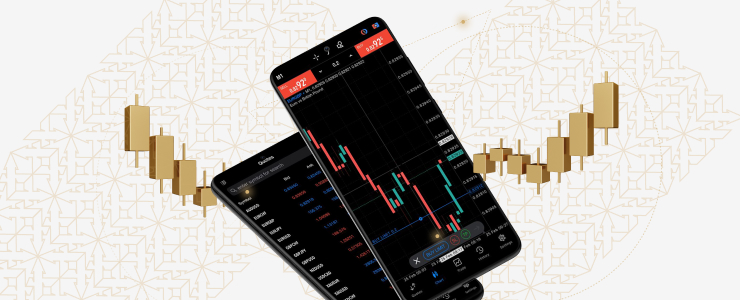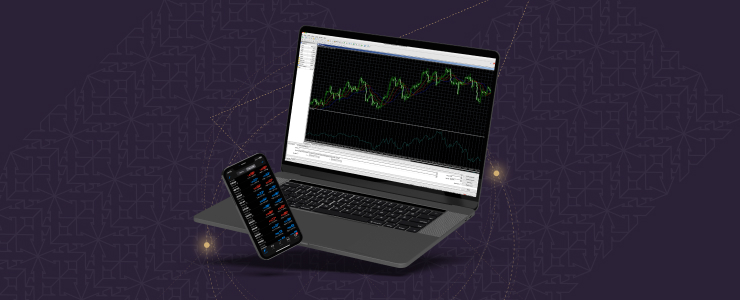Le trading sur le marché des changes peut offrir des opportunités intéressantes, mais il comporte également des risques. C’est pourquoi la gestion des risques est tout aussi importante que la mise en place d’une bonne stratégie. Même les traders professionnels ayant des années d’expérience peuvent perdre de l’argent s’ils ne disposent pas d’une solide gestion des risques sur le marché des changes.
Lisez cet article pour découvrir les principaux conseils en matière de gestion des risques sur le marché des changes qui peuvent vous aider à protéger votre capital comme un trader expérimenté, en particulier en période de volatilité des marchés.
Qu’est-ce que la gestion des risques ?
Le risque fait naturellement partie du trading sur le marché des changes. Les marchés pouvant évoluer soudainement et les devises pouvant également être imprévisibles, même les traders expérimentés peuvent parfois se tromper. C’est pourquoi la gestion des risques est importante.
En termes simples, la gestion des risques désigne les méthodes et les outils utilisés par les traders pour réduire les pertes potentielles et protéger leur capital de trading. Elle fait référence à la capacité à se préparer à des situations incertaines tout en s’assurant qu’aucune transaction ne puisse affecter négativement votre compte de trading.
Une gestion rigoureuse des risques ne consiste pas seulement à éviter les pertes, mais aussi à les contrôler afin qu’elles n’affectent pas vos objectifs de trading à long terme. Les traders expérimentés savent bien que le succès ne se résume pas à générer des revenus. Il s’agit également de protéger vos fonds grâce à la discipline, à la planification et à la prise de décisions judicieuses.
Conseils en matière de gestion des risques : définissez des ordres stop-loss pour limiter les pertes potentielles, déterminez clairement la taille de vos positions afin qu’aucune transaction ne nuise à votre compte et respectez une stratégie bien planifiée. En examinant régulièrement vos transactions et en ajustant votre approche en fonction des performances passées, vous pouvez renforcer davantage votre gestion des risques.

Conseils clés pour la gestion des risques
Après avoir vu ce que signifie la gestion des risques sur le marché des changes, nous allons maintenant examiner de plus près les stratégies pratiques que vous pouvez utiliser pour protéger vos fonds lorsque vous négociez sur le marché des changes.
Ne risquez que ce que vous pouvez vous permettre de perdre.
Ne jamais risquer de l’argent que vous ne pouvez pas vous permettre de perdre est peut-être la règle la plus importante dans le trading forex. Cela inclut les économies d’urgence, les fonds empruntés ou l’argent destiné au loyer. Les traders expérimentés ne risquent généralement qu’une petite partie de leur compte de trading par transaction. Cela représente généralement 1 à 2 %. Par exemple, si le total de votre compte est de 5 000 $, ne risquez pas plus de 50 à 100 $ par transaction. Cela vous protège contre des pertes plus importantes et vous aide à survivre à des transactions perdantes sans « détruire » votre compte.
Utilisez des ordres stop-loss et take-profit
Un ordre stop-loss clôture automatiquement une transaction dès que le cours évolue dans un sens défavorable pour vous d’un montant spécifique. Il s’agit d’un filet de sécurité. Il est important d’utiliser un ordre stop-loss pour chaque transaction, car il empêche les émotions de prendre le dessus et limite votre perte potentielle maximale.
Sans stop-loss, vous risquez de subir des pertes pendant une longue période, dans l’espoir que le cours évolue en votre faveur. Cela conduit souvent à des pertes encore plus importantes. Évitez d’éloigner votre stop-loss lorsque la transaction commence à évoluer en votre défaveur. Tenez-vous en à votre plan et acceptez les pertes.
Tout comme vous gérez vos pertes, vous devez également planifier vos profits. Un ordre take-profit permet de sécuriser automatiquement vos profits, vous aidant ainsi à rester discipliné et à éviter les décisions basées sur vos émotions.
Utilisez l’effet de levier à bon escient
L’effet de levier vous permet de négocier une position importante avec un montant initial modeste. Si cela augmente les profits, cela peut également accroître les pertes.
De nombreux traders débutants utilisent à mauvais escient l’effet de levier et prennent des positions plus importantes qu’ils ne peuvent gérer. Les professionnels utilisent un effet de levier faible ou modéré, en fonction de leur stratégie et de leur tolérance au risque. Avant d’utiliser l’effet de levier, réfléchissez toujours à ce que vous pourriez perdre si la transaction tourne mal. Il est très utile de connaître les risques avant de rechercher des profits.
Suivez un plan de trading
Un plan de trading, qui est un ensemble de règles guidant les décisions, est important pour tous les traders et comprend généralement :
- Les paires de devises cibles
- Règles d’entrée et de sortie
- Niveaux de stop-loss et de take-profit
- Risque maximal par transaction
- Nombre maximal de transactions par jour ou par semaine.
Un bon plan vous aide à rester discipliné et cohérent afin d’éviter les décisions émotionnelles et impulsives. Les traders professionnels révisent et ajustent régulièrement leur plan en fonction des résultats. Si quelque chose ne fonctionne pas, ils l’ajustent et le modifient après une analyse minutieuse, et non au milieu d’une transaction perdante.
Contrôler ses émotions dans le trading
Les émotions telles que la peur, la cupidité ou la frustration peuvent conduire à de mauvaises décisions de trading, notamment le fait de conserver des positions perdantes ou de sur-trader après une transaction efficace. La gestion des risques permet de réduire ces émotions, car vous savez exactement combien vous pouvez perdre avant le début de la transaction.
D’autres moyens de contrôler ses émotions consistent à réduire la taille des transactions, à faire des pauses après des pertes ou des gains, à tenir un journal de trading pour réfléchir à son comportement et à se fixer des objectifs réalistes. Il est important d’avoir une bonne stratégie de trading, mais il est tout aussi important de trader de manière calme et rationnelle.
Restez informé des actualités et des événements du marché
Les marchés Forex sont fortement influencés par l’actualité, notamment les décisions des banques centrales, les rapports sur l’inflation et les questions géopolitiques. Les nouvelles inattendues peuvent entraîner une forte volatilité, rendant les transactions plus risquées. Essayez de toujours consulter le calendrier économique et soyez prudent lorsque vous négociez autour d’événements clés du marché. De nombreux traders expérimentés évitent d’ouvrir des positions juste avant l’annonce d’une nouvelle importante et ferment parfois même leurs positions pour éviter des mouvements imprévus.

Examen et ajustement de la gestion des risques
La gestion des risques ne se limite pas aux règles que vous définissez dans votre plan de trading. Elle consiste également à tirer des enseignements de la pratique et de l’expérience. Tenez un journal de trading et notez les raisons pour lesquelles vous avez conclu la transaction, vos niveaux de stop-loss et de take-profit, tout ce qui s’est passé ainsi que ce que vous avez appris. À long terme, cela vous aidera à repérer vos erreurs et à vous améliorer. L’apprentissage continu vous aide à adapter votre gestion des risques sur le Forex tout en progressant en tant que trader.
Savoir quand prendre du recul
Il y aura des moments où la meilleure gestion des risques consistera à prendre du recul. Si vous êtes sur une série de transactions perdantes ou si vous vous sentez émotif, il est normal de faire une pause et d’arrêter de trader. Protéger votre capital signifie également protéger votre concentration mentale. Vous pouvez faire une pause, vous ressourcer et revenir avec l’esprit clair. N’oubliez pas que le marché sera toujours là, alors ne vous précipitez pas.
Utiliser le ratio risque/récompense
Le montant que vous risquez et le montant que vous espérez gagner sont comparés à l’aide d’un ratio risque/récompense. Un exemple courant de ratio est 1:2, ce qui signifie que vous risquez 50 $ pour gagner 100 $. Cela signifie également que vous n’avez pas besoin de gagner chaque transaction pour être efficace. Par exemple, si vous gagnez 50 % des transactions avec un ratio de 1:2, vous générerez tout de même un revenu global. Avant de vous lancer dans une transaction, assurez-vous que la récompense potentielle vaut le risque.
Diversifiez et adaptez la taille de vos transactions
Choisissez toujours la taille de transaction appropriée en fonction du risque que vous êtes prêt à prendre. Si, par exemple, vous risquez 100 $ et que votre stop-loss est à 50 pips, utilisez une taille de position qui ne vous ferait perdre que 100 $ si le stop était atteint. Les calculateurs de trading en ligne peuvent vous aider à cet égard. Diversifiez également vos transactions. Ne risquez pas tout sur une seule paire. Négociez différentes devises ou différents instruments afin de répartir les risques. Évitez toutefois d’effectuer trop de transactions en même temps. Concentrez-vous sur quelques configurations de qualité que vous pouvez bien contrôler et gérer.

Dernières réflexions sur la gestion des risques
La gestion des risques ne fait pas seulement partie du trading. Elle constitue le fondement d’un parcours de trading plus solide. Sans elle, les profits n’ont aucune importance, car une seule mauvaise transaction peut tout effacer. Les traders professionnels prévoient les pertes et protègent leur capital avant tout. En utilisant des ordres stop-loss, en gérant l’effet de levier, en dimensionnant correctement les positions et en contrôlant vos émotions, vous pouvez trader en toute confiance. Faites de la gestion des risques sur le Forex une habitude dans votre trading, protégez votre capital comme un professionnel et le reste suivra.
Avertissement : Ces informations ne constituent pas un conseil en investissement ni une recommandation d’investissement, mais une communication marketing.




